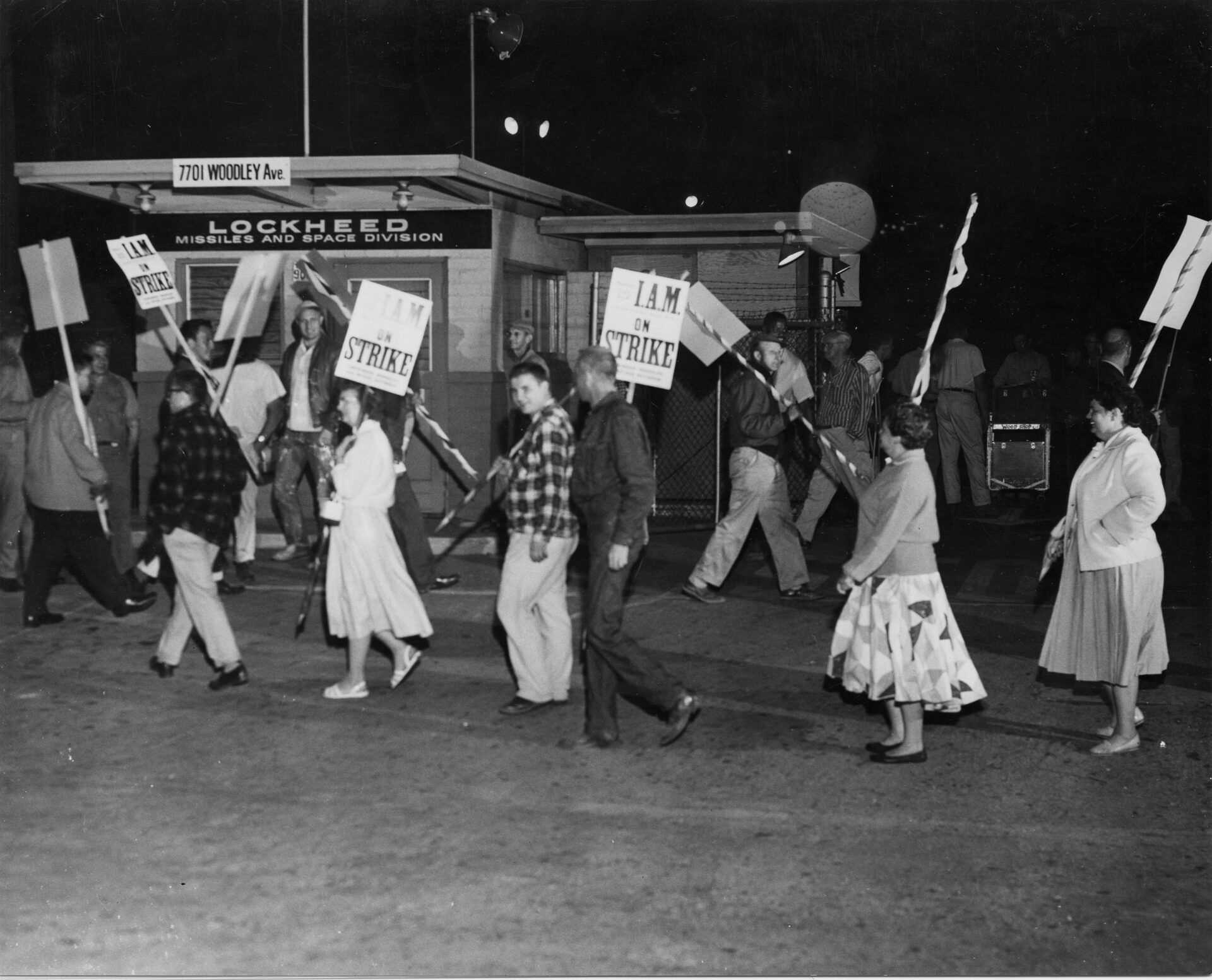The defense industry has shed millions of jobs, dropped average salaries, and battered its unions in recent decades, meaning that, from a labor perspective, a job in the military-industrial complex just isn’t what it used to be.
That may be, in part, because it’s also not where it used to be.
Inkstick Media systematically examined more than a hundred announcements of corporate expansions and relocations between 2010 and 2022 for the top five defense contractors that dominate the US defense contracting market. We read through every publically available press release regarding such moves on the companies’ websites for the sample years to gather every relevant announcement and then analyzed the trends. We also combed through reports in trade magazines and reams of ribbon-cutting photos of local officials and company executives touting the new jobs a plant would bring to town. The companies themselves don’t publish such a dataset, so we made one ourselves.
The announcements compiled in Inkstick’s dataset include major ones like Lockheed Martin’s relocation of its F-16 plant from a unionized shop in Fort Worth to Greenville, S.C., a state with the country’s lowest unionization rate and whose former governor, Nikki Haley, boasted that she wears high heels in order to kick organized labor out of the state. The moves also include incremental ones that receive little attention outside of local media, like Northrop Grumman announcing a few dozen new jobs related to expanded production in an existing plant in southern Mississippi. The resulting data showed that in their site selection choices, those top contractors favored “right-to-work” states — where laws undermine union strength — over union-friendly states by a factor of about 1.5. (Explore Inkstick Media’s interactive map, below, to see where companies chose to relocate and expand.)
Top Five Defense Contractors Favor Relocations, Expansions in "Right-to-Work" States
There are shortcomings to using such announcements as a measure of an industry’s affinity for “right-to-work” states. For example, watchdogs and local media have often chronicled exaggerated or misleading job creation claims made by companies and local governments in so-called “incentive” deals to subsidize companies’ moves to a new location, meaning that an announcement may actually have few real new jobs behind it. We’ve based our analysis on expansion and relocation announcements rather than total jobs because many of the announcements include no employment estimates, instead using vague statements, such as “future growth opportunities,” that just suggest job creation. Still, the array of announcements suggests an important trend: that an industry flush with taxpayer dollars is subverting the organized labor on whose backs those companies rose to their current dominance of the defense contracting market.
How “Right-To-Work” Works
In its fine print, “right-to-work” laws function like this: Per federal law, no one is ever forced to join a union. But a union at a given shop must represent all workers, whether they are a member or not. In states friendly to organized labor, workers who choose not to join their shop’s union still pay a “fair share” fee to the union to compensate them for labor-intensive services like representing workers who want to challenge their firing. In right-to-work states, non-members don’t pay any such fee and become “free riders” on the benefits the union provides.
But a state’s passage of right-to-work laws is about more than just that technical detail, Christian Sweeney, the deputy organizing director at the AFL-CIO and a historian by training, told Inkstick Media.
“It’s emblematic of a broader set of politics that are more detrimental not just to your members, but to workers in those states generally” – such as lower standards and fewer inspectors at the state’s Occupational Safety and Health Administration, he said. “Typically, these are states with the historical legacy of slavery, a cycle of under-development, and so they tend to be lower wage states in general,” he added.
The Gunbelt
The map of the American military-industrial complex has shifted in its eight decades of existence.
America’s private defense industry was born in Connecticut when, in 1798, cotton gin manufacturer Eli Whitney became the War Department’s first contractor with a deal to supply the Army 10,000 muskets. (The descendant aircraft engine maker that still bears his name, Pratt & Whitney, continues to be a major military contractor and has whittled away at its union in labor-friendly Connecticut by shifting work to plants in Southern “right-to-work” states like Georgia and North Carolina.) Still, in America’s early years, the Army and the Navy often preferred designing and developing weapons at their own arsenals and Navy yards rather than outsourcing to private companies.
A sharp change occurred in 1942, when hundreds of manufacturers received marching orders from the newly formed War Production Board to convert their civilian operations to weapons ones. The defense industry was then concentrated in aircraft and shipbuilding, with operations largely in the Northeast and Midwest. That alliance between for-profit companies and the military lasted well beyond the end of the war, giving rise to the military-industrial complex of today, which, during the Cold War, oversaw an unprecedented industrial remapping of America as it steered taxpayer funds to new weapons hubs like Huntsville, Ala., and Southern California.
As a new postwar industrial policy of job creation via weapons spending was taking off, an anti-labor one was also gaining steam: the rise of “right-to-work” laws in conservative states that were often the beneficiaries of that spending. Those laws have their origins in opposition to the New Deal and conservative states’ alarm over seeing Black and white workers come together in the union movement, according to Sweeney from the AFL-CIO, who called that multiracial coalition an “anathema” to monied interests in the South, a region blanketed in such laws.
About fifty years and trillions of dollars into the Cold War, four academics set out to document the remarkable shift of industry and jobs out of America’s heartland during that time. In their 1991 book, “The Rise of the Gunbelt,” they cataloged the economic transfer to a zone unevenly strung around America’s perimeter:
“[I]n their general shape, superimposed on the map of America, these new military-industrial regions do indeed resemble the belt around the hips of the solitary sheriff in pursuit of the bad guys in an old western movie. The southwestern states, Texas and the Great Plains, make up the holster; Florida represents the handcuffs ready to be slipped on the wrists of the villains; New England is the bullet clip,” the authors wrote. “It is unprecedented in modern world history; no other Western industrial nation has seen so much of its leading-edge industrial capacity located, in so extraordinarily short a time, so far from the original centers of commerce and production.”
The authors argued that the military-industrial migration created a geopolitical shift that, in turn, tightened military spending’s control over the economy. As workers and their families followed the dollars and jobs to new enclaves along the Gunbelt, congressional maps shifted to represent those new populations, which then elected Republicans and hawkish Democrats. “We speculate this has had a strong positive-feedback effect on military procurement per se,” they wrote, “as certain congressional delegations push for the continuation of weapons programs that are essential to their local economies.”
Inkstick Media’s analysis of corporate expansions and relocations shows that the authors’ words have held up in the more than thirty years since they were written, as Gunbelt states like Texas, Alabama, Georgia, Florida, and Maryland continue to be choice locations for top defense contractors.
Fewer Jobs, Lower Pay
Nowadays, the Biden administration is seeking to connect federal spending and unionization, arguing that taxpayer money should be used to create good jobs. But the federal government’s largest contractors — the defense ones — have battered their unions in recent years, as Inkstick revealed in an investigation in June.
At Lockheed, for example, at least 69% of workers were unionized in 1971. Just 19% were in 2022. At Northrop Grumman, only 4% of workers are unionized. That dwindling union strength comes as the private defense industry has shed millions of jobs: While an estimated 3 million people were employed in the private defense industry in 1985, that number fell to 1.1 million in 2021, according to the National Defense Industrial Association. And by one key measure, the remaining jobs in the industry have worsened: Average annual salaries dropped by several thousand dollars over that same time period, according to the NDIA.
Sweeney said the anti-labor moves raise the question of what Americans are getting in exchange for their tax dollars funneled to defense giants.
“If we’re going to spend public dollars to buy anything from rail cars to bombers to ammunition to pickup trucks, if public money is going to be used to do that, shouldn’t we do that in a way that supports other public goods and other things we value?”




















